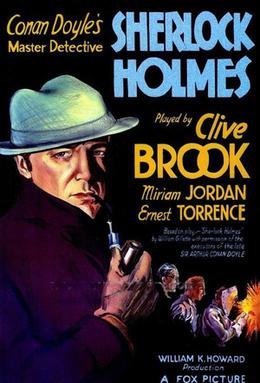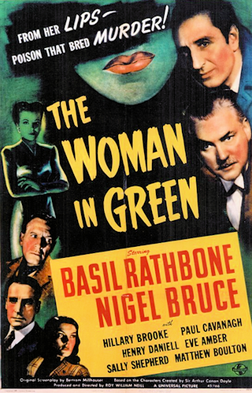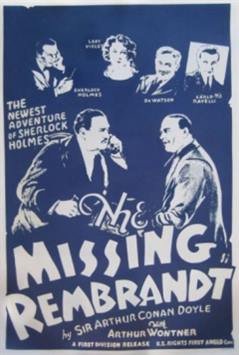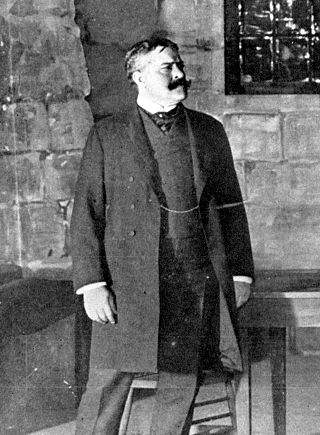Related Research Articles

Detective Inspector G. Lestrade, or Mr. Lestrade, is a fictional character appearing in several of the Sherlock Holmes stories written by Arthur Conan Doyle. Lestrade's first appearance was in the first Sherlock Holmes story, the novel A Study in Scarlet, which was published in 1887. The last story in which he appears is the short story "The Adventure of the Three Garridebs", which was first published in 1924 and was included in the final collection of Sherlock Holmes stories by Doyle, The Case-Book of Sherlock Holmes.
The Baker Street Boys is a British television series made by the BBC and first shown in 1983. The series recounts the adventures of a gang of street urchins living in Victorian London who assist the legendary detective Sherlock Holmes in solving crimes and find themselves tackling cases of their own.

The Hound of the Baskervilles is a 1959 British gothic mystery film directed by Terence Fisher and produced by Hammer Film Productions. It is based on the 1902 novel of the same title by Sir Arthur Conan Doyle. It stars Peter Cushing as Sherlock Holmes, Sir Christopher Lee as Sir Henry Baskerville and André Morell as Doctor Watson. It is the first film adaptation of the novel to be filmed in colour.
Arthur Wontner was a British actor best known for playing Sir Arthur Conan Doyle's master detective Sherlock Holmes in five films from 1931 to 1937.

The Adventures of Sherlock Holmes is a 1939 American mystery adventure film based on Sir Arthur Conan Doyle's Sherlock Holmes detective stories. Although claiming to be an adaptation of the 1899 play Sherlock Holmes by William Gillette, the film bears little resemblance to the play.

Sherlock Holmes is a 1932 American pre-Code film starring Clive Brook as the eponymous London detective. The movie is based on the successful stage play Sherlock Holmes by William Gillette, in turn based on the stories by Arthur Conan Doyle, and is directed by William K. Howard for the Fox Film Corporation. Brook had played Holmes previously in The Return of Sherlock Holmes and the "Murder Will Out" segment of Paramount on Parade.

The Woman in Green is a 1945 American film, the eleventh of the fourteen Sherlock Holmes films based on the characters created by Arthur Conan Doyle. Produced and directed by Roy William Neill, it stars Basil Rathbone as Sherlock Holmes and Nigel Bruce as Dr. Watson, with Hillary Brooke as the woman of the title and Henry Daniell as Professor Moriarty. The film follows an original premise with material taken from "The Final Problem" (1893) and "The Adventure of the Empty House" (1903).

The Sleeping Cardinal, also known as Sherlock Holmes' Fatal Hour in the United States, is a 1931 British mystery film directed by Leslie S. Hiscott and starring Arthur Wontner and Ian Fleming. The film is an adaptation of the Sherlock Holmes stories by Arthur Conan Doyle, although it is not based on any one particular story it draws inspiration from "The Empty House" and "The Final Problem".

The Sign of Four is a 1932 British crime film directed by Graham Cutts and starring Arthur Wontner, Ian Hunter and Graham Soutten. The film is based on Arthur Conan Doyle's second Sherlock Holmes novel The Sign of the Four (1890). The film is also known as The Sign of Four: Sherlock Holmes' Greatest Case.

Silver Blaze is a 1937 British, black-and-white crime and mystery film, based loosely on Arthur Conan Doyle's 1892 short story "The Adventure of Silver Blaze". It was directed by Thomas Bentley, and was produced by Twickenham Film Studios Productions. It stars Arthur Wontner as Sherlock Holmes, and Ian Fleming as Dr. Watson. In the United States, the film was released in 1941 by Astor Pictures, where it was also known as Murder at the Baskervilles, retitled by distributors to capitalize on the success of the Basil Rathbone Holmes film, The Hound of the Baskervilles.

The Triumph of Sherlock Holmes is a 1935 British mystery film directed by Leslie S. Hiscott and starring Arthur Wontner. It was based on the 1915 Sherlock Holmes novel The Valley of Fear by Arthur Conan Doyle.

The Missing Rembrandt is a 1932 British mystery film directed by Leslie S. Hiscott and starring Arthur Wontner, Jane Welsh, Miles Mander, and Francis L. Sullivan. It is considered a lost film. The film was loosely based on the 1904 Sherlock Holmes story "The Adventure of Charles Augustus Milverton" by Arthur Conan Doyle.

The Hound of the Baskervilles is a 1972 American made-for-television mystery film directed by Barry Crane and starring Stewart Granger as Sherlock Holmes and Bernard Fox as Doctor Watson. The movie is based on Arthur Conan Doyle's 1902 Sherlock Holmes novel The Hound of the Baskervilles.
From 1921 to 1923, Stoll Pictures produced three series of silent black-and-white films based on Sir Arthur Conan Doyle's Sherlock Holmes stories. Forty-five short films and two feature-length films were produced featuring Eille Norwood in the role of Holmes and Hubert Willis cast as Dr. Watson with the exception of the final film, The Sign of Four, where Willis was replaced with Arthur Cullin. Consequently, Norwood holds the record for most appearances as Sherlock Holmes in film.
Der Hund von Baskerville is a 1914 German silent film adaptation of Arthur Conan Doyle's 1902 novel The Hound of the Baskervilles, the first film adaptation of the work. According to the website silentera.com, the film was considered lost, but has been rediscovered; the Russian Gosfilmofond film archive possesses a print, while the Filmmuseum München has a 35mm positive print.
The Hound of London is a television film directed by Peter Reynolds-Long and starring Patrick Macnee as Arthur Conan Doyle's character Sherlock Holmes.

Professor James Moriarty is the fictional archenemy of Sherlock Holmes in some of the stories written by Sir Arthur Conan Doyle. He has appeared in several forms outside of the original stories.
The Three Garridebs is a 1937 television presentation that aired on NBC, based on Sir Arthur Conan Doyle's 1924 story "The Adventure of the Three Garridebs". Louis Hector played Sherlock Holmes, the first actor to do so on television.
References
- ↑ Arthur Wontner at IMDb
- 1 2 Barnes, Alan (2002). Sherlock Holmes on Screen. Reynolds & Hearn Ltd. pp. 193–194. ISBN 1-903111-04-8.
- 1 2 Bunson, Matthew (1997). Encyclopedia Sherlockiana. Simon & Schuster. p. 290. ISBN 0-02-861679-0.
- 1 2 3 4 5 6 7 8 9 Eyles, Allen (1986). Sherlock Holmes: A Centenary Celebration . Harper & Row. pp. 81–83. ISBN 0-06-015620-1.
- ↑ Barnes, Alan (2002). Sherlock Holmes on Screen. Reynolds & Hearn Ltd. p. 175. ISBN 1-903111-04-8.
- 1 2 3 4 5 6 7 Allen Eyles (1986). Sherlock Holmes: A Centenary Celebration . Harper & Row. pp. 86–88. ISBN 0-06-015620-1.
- 1 2 3 4 5 Barnes, Alan (2002). Sherlock Holmes on Screen. Reynolds & Hearn Ltd. pp. 219–220. ISBN 1-903111-04-8.
- ↑ Barnes, Alan (2002). Sherlock Holmes on Screen. Reynolds & Hearn Ltd. p. 178. ISBN 1-903111-04-8.
- 1 2 3 4 Detective-Mystery Films
- ↑ Murder At The Baskervilles (1937)
- ↑ Byrne, Bob (29 December 2014). "The Public Life of Sherlock Holmes: Arthur Wonter, The Third Great Holmes". Black Gate . Retrieved 22 September 2023.
- ↑ Starrett, Vincent (1933). The Private Life of Sherlock Holmes . The Macmillan Company. p. 158. ISBN 1-883402-05-0.